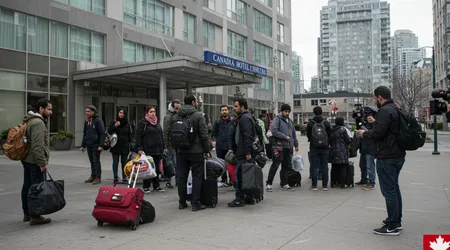Canada Halts Hotel Housing for Asylum Seekers After Spending $1.1B Since 2020

Canada halts hotel housing for asylum seekers, marking a significant shift in how the nation addresses the needs of those seeking refuge.
Since 2020, the federal government has spent $1.1 billion on temporary hotel accommodations for asylum seekers, a stopgap measure to manage a surge in claims that overwhelmed shelters in cities like Toronto and Montreal.
As Immigration, Refugees and Citizenship Canada (IRCC) announces the end of this program by September 30, 2025, the decision sparks debate about Canada’s humanitarian obligations, strained housing systems, and fiscal priorities.
This article dives into the complexities of this policy change, exploring its implications for asylum seekers, taxpayers, and Canada’s broader immigration framework. Why does this moment feel like a crossroads for the nation’s identity as a beacon for refugees?
The Rise and Fall of Hotel Housing
The hotel housing program began in 2017 as an emergency response to unprecedented asylum claims. Shelters buckled under the influx, particularly in Ontario and Quebec, where most claimants arrived.
By 2024, claims soared to 173,000, up from 50,365 in 2017, forcing the government to block-book hotels. At its peak, IRCC leased rooms in 46 hotels nationwide, costing $205 per night per claimant.
This temporary fix, though, became a lightning rod for criticism. Taxpayers questioned the $1.1 billion price tag, especially amid Canada’s housing crisis.
++ Canadian Businesses Less Worried About Worst-Case Tariff Scenarios
The program, never meant to be permanent, housed 485 asylum seekers in five hotels by July 2025, a sharp drop from earlier years.
The decision to end funding reflects fiscal pressures and public frustration. Yet, it leaves a critical question: can Canada uphold its refugee commitments without sustainable alternatives?
The government’s pivot demands innovative solutions to avoid leaving vulnerable people in the lurch.

Humanitarian Obligations vs. Economic Realities
Canada, a signatory to the 1951 UN Refugee Convention, must provide shelter and safety to asylum seekers.
The hotel program was a pragmatic, if costly, way to meet this obligation. However, with municipal shelters at capacity and affordable housing scarce, the end of Canada halts hotel housing for asylum seekers raises alarms among advocates.
Adaoma Patterson, director at United Way Greater Toronto, warns that asylum seekers face homelessness risks without stable housing options.
Also read: Canada Introduces New Steel Tariffs to Shield Domestic Producers
In 2023, two asylum seekers died in Mississauga due to lack of shelter, a stark reminder of the stakes. The IRCC claims over 15,000 claimants transitioned to independent living, but the remaining 485 face uncertain futures.
Economic realities complicate the picture. Provinces and municipalities, already stretched, may inherit the burden.
Christopher Worswick, a Carleton University economist, notes that shifting costs to cash-strapped local governments could strain public services further. Can Canada balance its humanitarian heart with its fiscal head?
The Housing Crisis Connection
The hotel program’s end intersects with Canada’s broader housing crisis. With rental vacancies in Toronto at 1.5% in 2024, finding affordable homes for asylum seekers is daunting.
Landlords often hesitate to rent to newcomers without credit histories, exacerbating the challenge. Canada halts hotel housing for asylum seekers, but where will these individuals go?
Consider Maria, a fictional Venezuelan asylum seeker. After fleeing violence, she stayed in a government-funded hotel in Niagara Falls.
With three days’ notice to vacate, she struggles to find a landlord willing to rent to her. Her story mirrors real cases where short eviction notices left claimants homeless.
Read more: Southeast Asia Trade Push
Municipalities like Peel Region have opened reception centers, like one housing 680 claimants near Toronto’s airport. Yet, these are short-term fixes.
Long-term housing solutions, like social housing investments, remain critical but underdeveloped. The housing crisis is a pressure cooker can it handle more strain?
Policy Shifts and Public Sentiment
The decision to end hotel funding comes amid broader immigration policy changes. The Strong Borders Act, proposed in 2025, aims to restrict asylum claims and speed up processing.
Critics argue it prioritizes control over compassion, potentially harming genuine refugees. Canada halts hotel housing for asylum seekers, but is it tightening the screws too far?
Public sentiment is polarized. Posts on X reflect frustration, with users like @lcfortier noting that provinces now inherit the $1.1 billion bill, fueling taxpayer discontent.
Others, like @ali_noorani_teh, highlight the reduced number of hotel-based claimants, suggesting progress. The debate mirrors a tug-of-war between Canada’s welcoming ethos and economic pragmatism.
The government’s move to issue “notices to vacate” in 2024 led to 13,000 claimants leaving hotels by March 2025.
While this eased costs, it sparked concerns about rushed transitions. Ontario Premier Doug Ford has criticized slow federal processing, noting asylum seekers wait over two years for work permits, delaying self-sufficiency.
A Path Toward Sustainable Solutions
Ending hotel funding signals a need for creative alternatives. IRCC is exploring options like buying hotels for conversion into reception centers, as proposed by former Immigration Minister Marc Miller in 2024.
Such centers could offer shelter, legal aid, and health services, streamlining support. Canada halts hotel housing for asylum seekers, but could repurposed buildings be the answer?
Another solution lies in faster claim processing. In 2022, IRCC introduced a policy granting work permits to asylum seekers sooner, with 53,000 issued by May 2023.
This reduces reliance on public funds, allowing claimants like John, a hypothetical Nigerian refugee, to work and rent independently within months.
Investing in affordable housing is also crucial. The Interim Housing Assistance Program (IHAP) allocated $1.1 billion over three years to support provinces, but experts call for more social housing.
Without it, asylum seekers risk falling through the cracks, like water escaping a cracked bucket.
Key Statistics on Asylum Seeker Housing Costs
| Year | Asylum Claims | Hotel Rooms Leased | Cost (CAD) |
|---|---|---|---|
| 2017 | 50,365 | 46 hotels | $205/night |
| 2024 | 173,000 | 4,050 rooms | $544M |
| 2025 | N/A | 5 hotels (485 people) | $1.1B (total) |
Source: Immigration, Refugees and Citizenship Canada (IRCC), July 2025
The Role of Regional Cooperation
Distributing asylum seekers across Canada could ease pressure on Ontario and Quebec. Since 2021, IRCC transferred 10,580 claimants from Quebec to other provinces, supported by IHAP funding.
This approach reduces urban strain but requires coordination. Canada halts hotel housing for asylum seekers, yet regional balance remains elusive.
Smaller provinces, like New Brunswick, have capacity but lack infrastructure. Financial incentives could encourage relocation, but local communities must be engaged to avoid backlash.
In 2024, Niagara Falls housed nearly 5,000 claimants, costing $115 million, showing the need for equitable distribution.
Public communication is key. Transparent dialogue about costs and benefits can temper frustration, as seen in X posts questioning fairness. By fostering cooperation, Canada can share the load, ensuring no province bears the brunt alone.
Looking Ahead: A Crossroads for Canada
As Canada halts hotel housing for asylum seekers, the nation stands at a pivotal moment. The $1.1 billion spent since 2020 underscores the scale of the challenge, but also the commitment to humanitarian values.
With only 485 claimants in hotels by July 2025, progress is evident, yet the path forward demands innovation.
The government’s pledge to help these individuals find housing is a start, but experts like Patterson warn of systemic gaps.
Municipal shelters can’t keep up, and the housing crisis looms large. Canada must invest in long-term solutions, from faster processing to social housing, to avoid repeating past mistakes.
This moment is like a ship navigating stormy waters steady hands can guide it to port, but missteps could lead to disaster. Canada’s identity as a refuge for the persecuted hangs in the balance.
Will it rise to the challenge, or let fiscal pressures overshadow its moral compass?
Frequently Asked Questions
1. Why did Canada stop funding hotel housing for asylum seekers?
The program, costing $1.1 billion since 2020, was a temporary measure. IRCC aims to transition claimants to sustainable housing by September 2025.
2. What happens to asylum seekers after September 2025?
IRCC will assist the remaining 485 claimants in finding long-term housing, though challenges persist due to low vacancy rates and shelter capacity.
3. How can Canada address the housing crisis for asylum seekers?
Solutions include faster claim processing, social housing investments, and regional relocation with financial incentives to balance the load across provinces.
This article blends hard data with human stories, like Maria’s struggle, to highlight the real-world impact of policy shifts.
By addressing Canada’s challenges head-on, it calls for solutions that honor both compassion and pragmatism.
